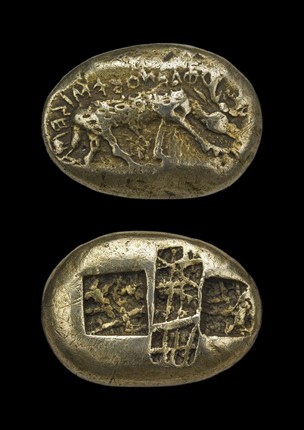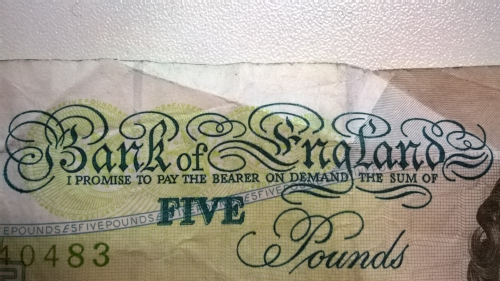All 1 entries tagged Electrum Stater
No other Warwick Blogs use the tag Electrum Stater on entries | View entries tagged Electrum Stater at Technorati | There are no images tagged Electrum Stater on this blog
December 01, 2015
A Word’s Worth: The Electrum Stater of Phanes
 |
| Electrum stater of Phanes |
This electrum stater was minted toward the end of the seventh century BC in western Asia Minor. The obverse depicts a grazing stag and bears the retrograde legend ΦΑΝΟΣ ΕΜΙ ΣΕΙΜΑ, “I am the marker of Phanes”. The reverse has three rectangular incuse designs with decussate lines.
As one of the earliest examples of European coinage bearing an inscription, the stater of Phanes helps us understand how our modern currency works: it is dependent on promises. Phanes’ stater was made of electrum, an alloy of gold and silver, making it highly valuable. However, that worth was not easily determined from just weighing it since gold and silver had different values, and one could not be sure of the gold: silver ratio in this particular coin. That means that this coin was of an unknown intrinsic value. However, with the introduction of the inscription, the minter gives a guarantee of the coin’s worth; in fact he stakes his own name on its value. The ancient Greek word “sēma” means “sign”, meaning the inscription reads “I am the sign of Phanes”. The legend makes the coin’s value representative of Phanes’ own wealth and reputation. Hence Phanes vouched for the value of any coin that bore this inscription, guaranteed against the fortune of which it was a part. This need for a guarantee of the value may reflect a mistrust in the consistency of unmarked contemporary electrum coins. Indeed, the continuation of the use of legends to provide provenance and accountability for minting shows the effectiveness of the legend as a guarantee in contrast to unembellished coinages. We can say that from such an early point in numismatic history, value and inscription were inseparable, in fact dependent upon one another. It is the legend that gives the coin its guaranteed value and it is the tangible value of the electrum that makes the guarantee of such a rich man worth anything at all.
 |
| Detail of modern day banknote |
This highlights the issue of modern banknotes. Paper money was first made in the ninth century AD during the Song Dynasty in China. It was created due to a shortage of copper (from which the state struck its coins), so instead the state issued paper on which were written promises to pay the bearer a specific sum at a later date. Indeed this is what it says on modern English banknotes today: “I promise to pay the bearer on demand the sum of X pounds”.
In the same way that Phanes promised a standardised value to this coinage, the Bank of England now guarantees the same on its banknotes. However, in modern times these written promises are traded as real money; there is no expectation that at a later date you will trade it in for coins or livestock of equivalent value. However, unlike Phanes’ stater, the paper (or rather polymer) on which modern money is printed has little or no intrinsic value. Intrinsic value and promise have been separated, and precious metals, which characterised early coinage, have disappeared from modern currencies. Rather it is the words guaranteeing the value of the currency that have proven more important and ultimately more valuable than gold or silver.
This shows how value is an imaginary idea determined subjectively by individuals as well as collectively by a community. This is a point that Aristotle picks up on in his Nicomachean Ethics V, v, 10-16:
money has become by convention a sort of representative of need; and this is why it has the name ‘money’ (nomisma)- because it exists not by nature but by law (nomos) and it is in our power to change it and make it useless. (trans. Ross 1980)
Ultimately a coin or banknote is only worth as much as you promise that it is worth. Try telling your bank that.
 |
This month's coin entry was written by Nick Brown. Nick is a first year MPhil/PhD student in the Department of Classics and Ancient History at Warwick. His PhD is a study of inscribed statues in the Archaic and Classical Periods in Greece. His academic interests focus on the theme of image and text, ranging from art and inscriptions of the Archaic period to the ekphrastic literature of the Second Sophistic.
Coin image © Trustees of the British Museum (see the coin in greater detail at the Google Cultural Institute).
 Clare Rowan
Clare Rowan

 Please wait - comments are loading
Please wait - comments are loading

 Loading…
Loading…

